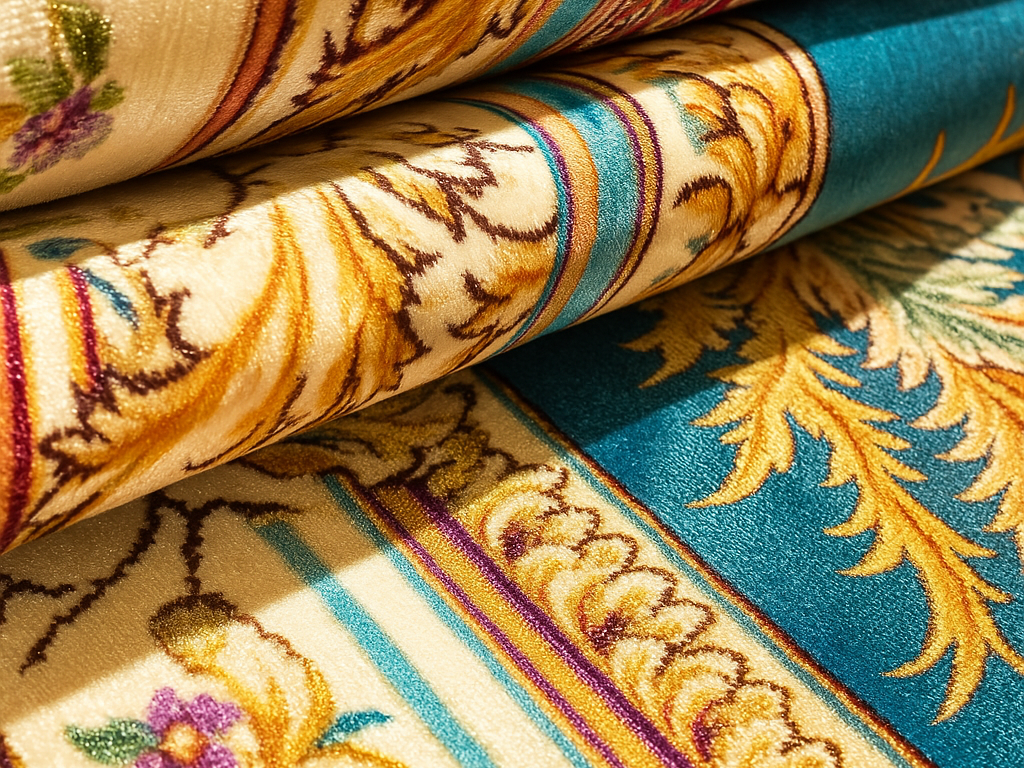Welcome home to warmth, texture, and timeless style. A wool rug isn’t just a decorative floor covering—it’s a luxurious, long-lasting investment rooted in centuries of craftsmanship and practical brilliance. In this comprehensive guide, we’ll unpack exactly what a wool rug is, break down its anatomy, explore its many benefits, walk through the key types, and share pro tips for choosing, caring for, and valuing your rug. Whether you’re hunting for a soft underfoot retreat or a durable statement piece, this article will equip you with the knowledge to make a confident, stylish, and value-packed decision
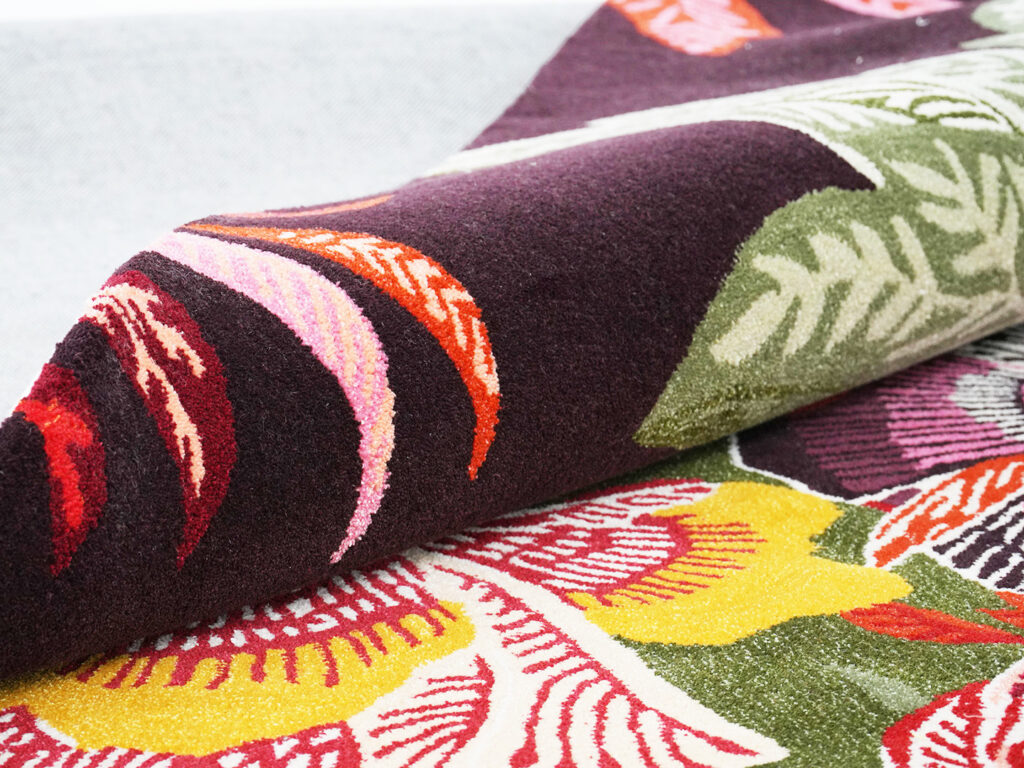
1. What Is a Wool Rug?
A wool rug is a floor covering woven, tufté, or knotted predominantly with wool fibers. Derived mainly from sheep—especially high‑quality, fine fibers such as New Zealand wool—it embraces durability, insulation, and a luxurious feel. Historically, wool has been prized in rug production since ancient times (sheep‑wool rugs tracing back to around 1500 BC).
Unlike synthetic materials, wool’s richness and texture stem from the unique structure of its fibers—natural crimp, elasticity, and a slightly coarse, tactile feel. It’s no surprise that in interior design, wool rugs remain iconic staples, adding both warmth and style.
2. The Anatomy of a Wool Rug
Understanding the anatomy of a wool rug means appreciating how each layer and component works together to deliver durability, artistry, and texture. Here’s a comprehensive breakdown:
Foundation: Warp & Weft
At the heart of every rug is its foundation—the framework that holds everything together.
- Warp threads run lengthwise and form the vertical skeleton. These are often what you see extended as fringe on hand-knotted varieties.
- Weft threads run horizontally and are interwoven with the warps to lock the structure in place.
- Foundations can be made of cotton, laine, or sometimes soie—each affects the rug’s flexibility, strength, and hand feel.
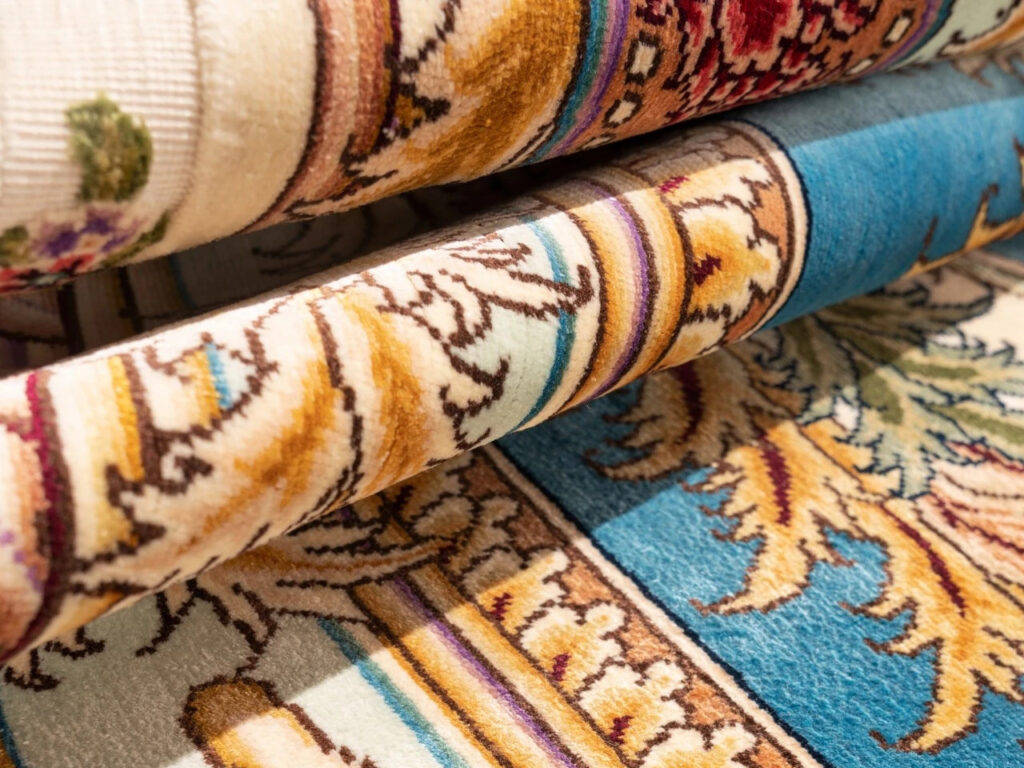
Pile & Knots
The pile is the plush surface that you feel underfoot, formed by countless individual knots.
- Knots are loops of wool yarn wrapped around pairs of warp threads and then cut to create pile height.
- Common knot types include:
- Turkish (Ghiordes) knot: symmetrical, offering dense, durable pile.
- Persian (Senneh) knot: asymmetrical, enabling finer detail.
- Knot density—measured in knots per square inch (KPSI)—is a key marker of quality. Higher counts mean tighter graphics and often longer wear.
Pile Height & Density
- Pile height varies from lofty plush to low and flat; plush rugs offer softness, while low-pile rugs handle traffic better.
- Densité isn’t just about pile height. It also reflects how tightly the knots are packed—denser rugs resist matting and foot traffic better.
Backing & Secondaire Treatment
- In tapis noués à la main, the backing is simply the tightly woven foundation—there’s no extra layer added.
- In hand‑tufted designs, artisans punch loops of wool through a cloth backing, secure them with latex glue, and then often apply a secondary backing (like canvas or felt) for stability and durability.
Edges, Selvedges & Fringe
- Selvedges (or shirazeh) are reinforced edges that prevent unraveling, typically wrapped in extra yarn or goat hair.
- Fringe is the exposed ends of the warp threads and often forms a decorative finish. On hand-knotted rugs, it’s both functional and ornamental.
Surface Design Elements
While pile and backing build the structure, style elements bring the rug to life:
- Field: The main area, showcasing color, texture, and central motifs.
- Medallions, spandrels, guard borders, and main borders define the patterning and visual narrative of the rug.
3. Benefits of Wool Rugs
Wool rugs stand apart in the home décor world thanks to their unique combination of comfort, performance, health, and sustainability. Let’s dive into the key advantages and understand why wool is a top-tier choice.
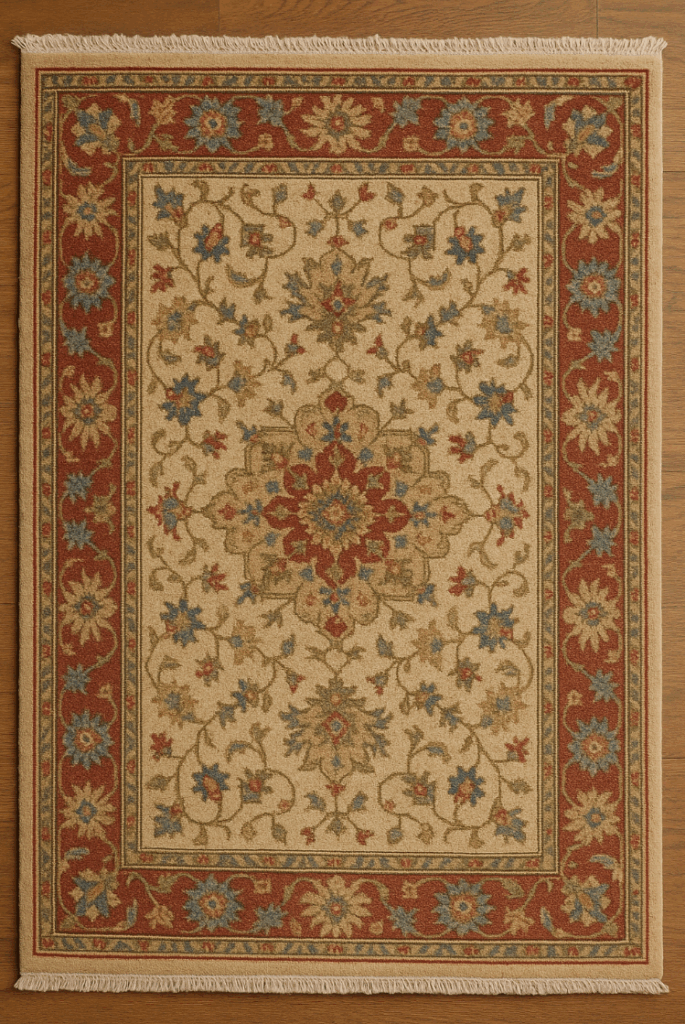
Durabilité et longévité
Wool is celebrated for its natural resilience. Its fibers possess elasticity—able to bend thousands of times without breaking—which helps wool rugs maintain their shape and structure under heavy foot traffic. In fact, high-quality wool rugs can endure for 25 to 100 years or more if properly cared for. Compared to synthetic rugs, wool resists matting and crushing, delivering exceptional value over time.
Natural Insulation & Comfort
Thanks to its crimped fibers, wool traps air effectively, offering insulation properties that help regulate indoor temperatures. It keeps spaces warm in winter and refreshingly cool in summer. The resulting plush texture underfoot delivers a cozy, inviting feel—ideal for bedrooms and living areas.
Stain Resistance & Easy Maintenance
Wool fibers contain lanolin, a natural oil that creates water- and stain-repellent surfaces. This means spills bead up initially, giving you precious time to blot before stains set in. Incorporate gentle vacuuming and quick spot-cleaning, and you can maintain your rug’s appearance with ease.
Health & Hypoallergenic Benefits
Contrary to myths about trapping allergens, wool naturally captures dust, pollen, and other tiny particles within its fibers, which are then released and removed during vacuuming—making wool rugs a smart choice for allergy-conscious homes. They also resist dust mites, mold, and bacteria, helping maintain better indoor air quality.
Flame Resistance & Safety
Wool is inherently flame-resistant. It self-extinguishes when ignited, unlike many synthetic materials, and emits minimal smoke and toxins. This natural safety feature makes it a wise choice for family homes, particularly with young children or fireplaces.
Acoustic & Thermal Benefits
In open-plan or multi-story homes, wool rugs serve as natural sound dampeners. Their dense fibers absorb ambient noise—from footsteps to echoes—creating a quieter, more restful environment.
Eco-friendliness & Sustainability
Wool is a renewable, biodegradable material. Sheep produce new fleece annually, and when wool rugs eventually wear out, they naturally decompose—unlike synthetic rugs that linger for decades in landfills. Many brands now use ethical sourcing and low-impact dyeing methods, enhancing wool’s sustainability credentials.
4. Types of Wool Rugs
Wool rugs come in a dazzling variety of styles and weaves. Here’s a breakdown of the most common types, each with distinct connotations of aesthetics, craftsmanship, durability, and price:
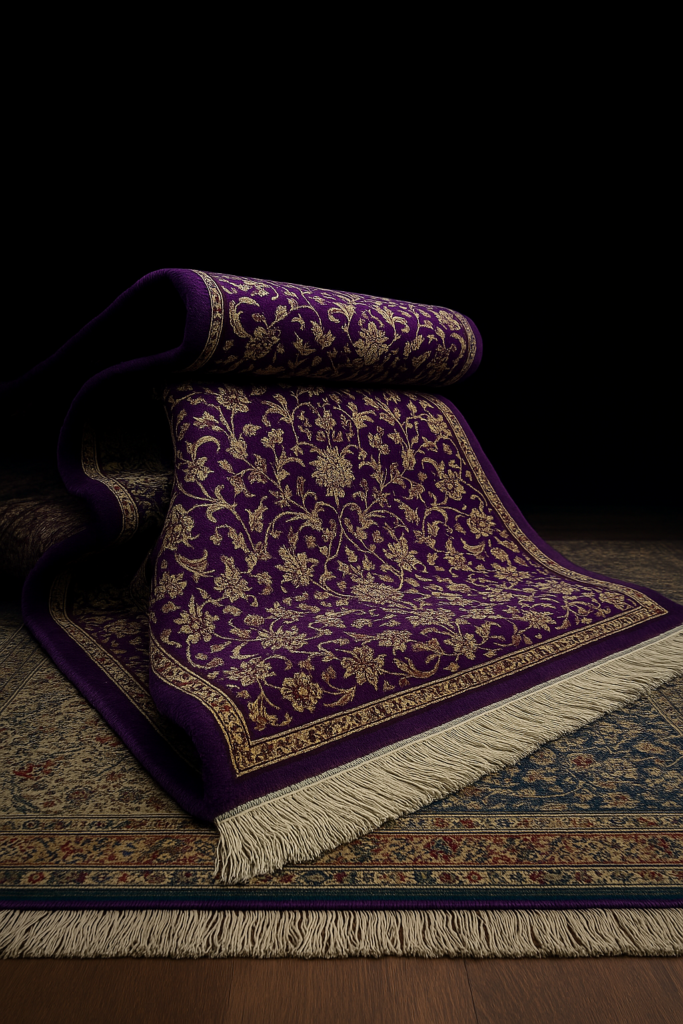
By Construction Method
Hand‑Knotted Rugs
- Each knot is meticulously tied by skilled artisans onto lengthwise warp threads—often made from cotton or wool.
- These represent the pinnacle of craftsmanship: durable, detailed, and often crafted over months or even years.
- Common styles include Persian, Turkish (Anatolian), and Gabbeh rugs, with knot densities defining clarity and longevity.
- Ideal for high-traffic areas and heirloom-quality investment pieces.
Hand‑Tufted Rugs
- Produced faster and more affordably: artisans use a hand-held “tufting gun” to punch wool through a canvas or fabric backing.
- A secondary backing (latex and canvas) secures the tufts; fringe is typically decorative rather than structural.
- Softer underfoot and visually appealing, but less durable than hand-knotted versions, with a lifespan of roughly 5–20 years.
Flat‑Woven Rugs (Kilims, Dhurries, Soumaks)
- Created without pile—just warp and weft—but still woven by hand.
- Lightweight, reversible, and typically featuring bold, geometric designs.
- Examples:
- Oriental kilims (Iran, Turkey).
- Gabbeh rugs from Iran: thick-pile Persian rugs with simplified, abstract designs.
- Varni kilims from Iran’s Shahsavan tribe.
Hand‑Loomed Rugs
- Historically, these rugs are woven on looms by hand—sometimes combining weaving and knotting.
- Faster to produce than full hand-knotted rugs, but still crafted with care.
- Offer good durability and a handcrafted look at a more moderate price point.
Machine‑Woven Rugs
- Created using power looms with synthetic blends or wool yarn.
- Highly affordable with consistent patterns and easy maintenance—but lack artisan charm and longevity.
By Regional & Cultural Style
Persian Rugs
- Hand-knotted masterpieces from Iran with dense structure, high knot count, and intricate floral or medallion motifs.
Turkish / Anatolian Rugs
- Symmetrical knotting (Ghiordes style), geometric designs, and rich color palettes.
Gabbeh Rugs
- Simplistic, artistic rugs with abstract color blocks and a plush hand. Traditionally made by tribal weavers in Iran.
Scandinavian Rya & Ryijy Rugs
- Rya (Sweden/Norway): High-pile, dense wool rugs used historically by sailors, now modern décor pieces.
- Ryijy (Finland): Beautiful, long-tufted tapestry-like rugs traditionally woven for ceremonial and decorative use.
Arraiolos Rugs
- Portuguese embroidered wool rugs using a unique cross-stitch technique on a canvas foundation.
By Pile Type & Practical Suitability
- High-Pile / Shag & Rya-Style: Luxuriously soft but typically more demanding to clean. The new short-pile shag trend (0.8–1″) offers better maintenance with a cozy feel.
- Low-Pile / Flat-Pile: Ideal for high-traffic areas—easier to sweep, vacuum, and maintain.
- Medium-Pile (e.g., Gabbeh): Balances tactile comfort with durability for moderate use.
5. How to Choose Wool Rugs
Selecting the perfect wool rug is about more than just good looks—it’s about practical decisions that will impact comfort, longevity, and value. Here’s a step-by-step guide to help buyers find the ideal match:
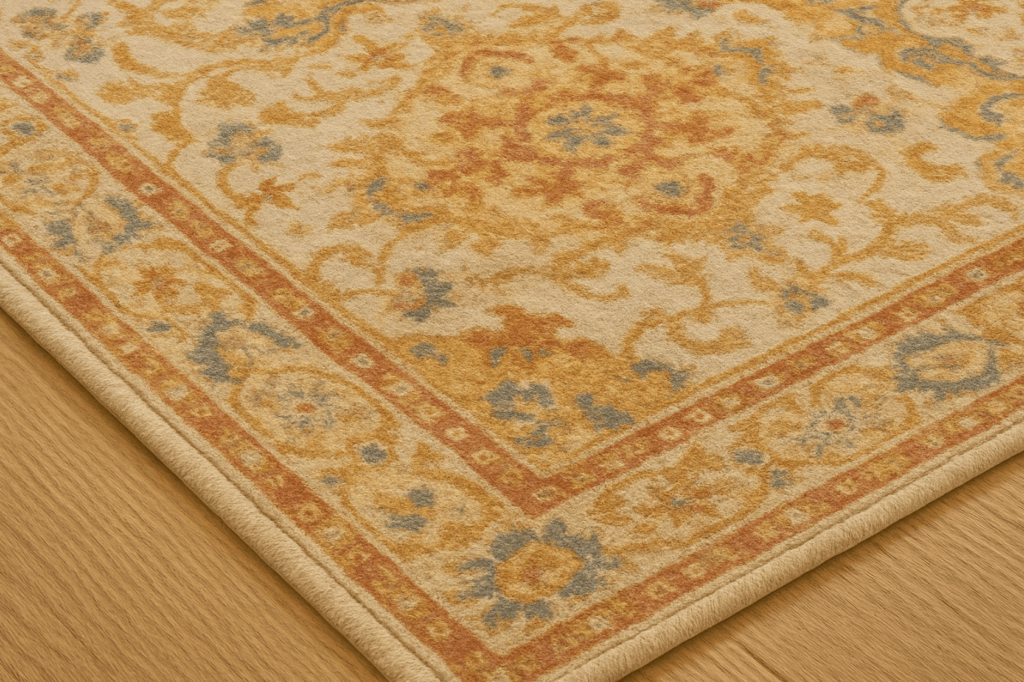
Step 1: Define Purpose & Placement
- Assess the room’s function: Will this rug sit in a high-traffic zone like a living room or hallway? Then opt for low-pile, tightly woven styles. If it’s more decorative or cozy—like in a bedroom—plush rugs work beautifully.
- Visualize layout: In living rooms, rugs should anchor furniture—ideally, at least the front legs of sofas or chairs should rest on it.
Step 2: Prioritize the Right Size & Shape
- Measure carefully: A rug too small can interrupt flow. Use painter’s tape to preview placement and scale.
- Size rules:
- Living room: Rug should extend beyond furniture edges.
- Dining room: Should accommodate chairs pulled back comfortably.
- Hallway: A runner covering most of the length is ideal.
Step 3: Choose Quality Construction
- Weave matters:
- Hand-knotted = top-tier durability and artistry.
- Hand-tufted = softer feel, budget-friendly, moderate lifespan.
- Flat-woven (kilims, dhurries) = reversible, easy to care for.
- Machine-woven = affordable, but usually less durable.
- Evaluate pile height:
- Low-pile (cut or loop) = better for traffic and easy cleaning.
- High-pile = plush and cozy, best in low-use zones.
Step 4: Examine the Material
- Wool quality:
- New Zealand wool → soft & resilient.
- Persian wool → thicker and longer-lasting.
- Blended fibers: Wool-silk blends offer sheen; wool-synthetic blends improve stain resistance.
Step 5: Consider Colors & Patterns
- Match decor: Choose neutrals to ground vibrant rooms; or go bold if the space is subdued.
- Hide wear: Busy patterns and mid-tone colors help conceal stains and foot marks.
Step 6: Look for Certifications & Eco Credibility
- Certifications from recognized bodies (e.g., Woolmark, GOTS) validate fiber quality and eco credentials.
- Ensure ethical sourcing and low-impact dyeing when sustainability matters.
Step 7: Calculate Cost vs. Long-Term Value
- Initial budget: Expect hand-knotted wool rugs to cost more upfront—but they offer decades-long durability.
- Total Value: Consider lifespan, ease of maintenance, and resale worth.
Step 8: Account for Pets & Special Needs
- For households with pets, prefer:
- Hand-knotted, dense wool
- Cut-pile over loop or shag (avoids claw snags).
- Mid-tone colors and subtle patterns to mask fur and dirt.
- Washable backings and rug pads for cleanliness and safety.
Step 9: Factor in Care & Maintenance
- Vacuum instructions: Use suction-only vacuum or gentle setting; avoid aggressive beater bars.
- Spill response: Blot spills quickly with mild wool-safe detergent.
- Professionally clean: Typically every 12–18 months, depending on usage.
Step 10: Inspect Before You Buy
- Check edges: Look for strong selvedges with no fraying.
- Knot density: High KPSI (knots per square inch) indicates quality, especially in hand-knotted rugs.
- Smell & look: Avoid musty odors or uneven dye absorption, which may indicate inferior wool or damp storage.
6. Care & Maintenance Tips for Wool Rugs
Proper care significantly extends the life and beauty of a wool rug. Follow these expert-backed tips to maintain its look, texture, and functionality for years to come.
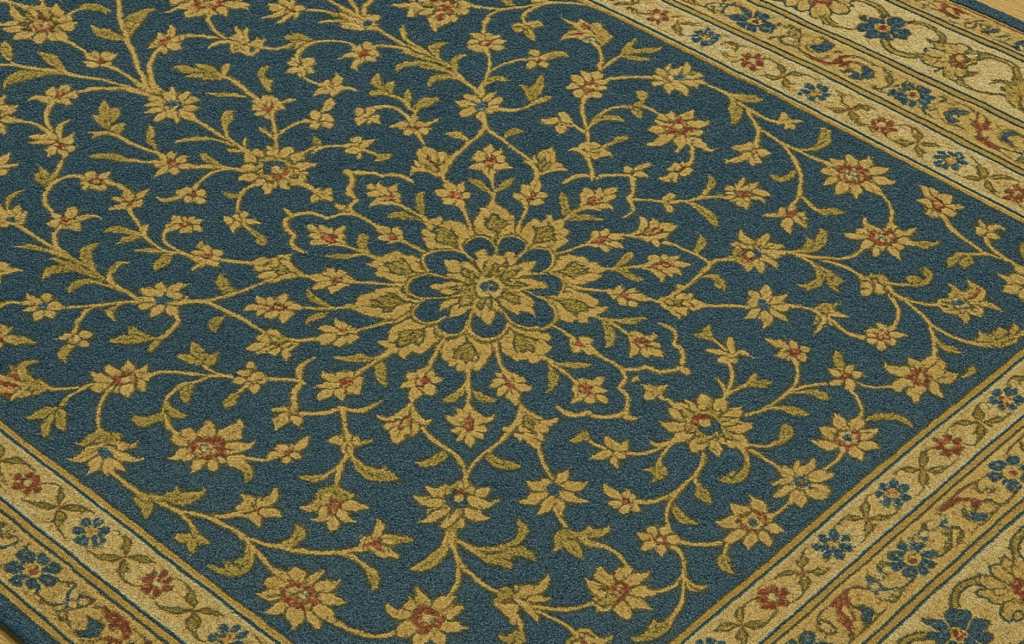
Routine Cleaning: Vacuum & Shake
- Vacuum weekly to remove dust and prevent soil buildup. Use a vacuum with gentle suction and no beater bar to avoid pulling fibers or damaging the weave.
- Beat or shake your rug outdoors periodically to dislodge embedded dirt—an age-old and effective method.
Rotate & Prevent Shade Fading
- Rotate rugs every 3–6 months to equalize wear and tear, especially in high-traffic zones or sun-exposed areas.
- Protect from strong sunlight, which can fade vibrant colors over time. Use curtains, blinds, or rotate periodically to mitigate damage.
Spot Cleaning Spills & Stains
- Act fast: Blot spills gently with a clean cloth—never rub, as this may damage fibers.
- Utiliser un wool-safe, non-bleaching cleaner or a gentle wool detergent. Always test in an inconspicuous area to prevent color fade.
- Pour tough stains, dab an enzyme-based cleaner, then rinse with a damp cloth, and air-dry—never over-wet the rug.
Nettoyage en profondeur et soins professionnels
- DIY deep cleaning at home should be gentle: use cool water, wool detergent, soft brush, and ensure thorough rinsing and drying.
- Air-dry flat or hang, preferably in mild sun but never in hot dryers—wool can shrink and distort when overheated.
- Experts recommend professional cleaning every 12–18 months, more often in homes with heavy foot traffic or pets.
Odor Control
- Sun exposure naturally deodorizes wool rugs—just be cautious of fading.
- For persistent smells, lightly sprinkle bicarbonate de soude, let sit, then vacuum thoroughly.
Rug Pads & Furniture Protection
- A quality rug pad is essential—it provides cushioning, inhibits slippage, and protects fibers from abrasion.
- Lieu coasters or pads under furniture legs to prevent permanent indentations.
Keep Pets & Debris at Bay
- No-shoes rule helps reduce dirt and oil buildup.
- Utiliser un rubber brush or vacuum tool to gently remove pet hair—wool’s natural oils help repel it, but buildup can still occur.
- Pour pet stains, blot immediately, neutralize with a vinegar-water mix, then follow up with a gentle wool detergent.
What to Avoid
- Don’t use bleach, ammonia, or harsh cleaners—they can strip lanolin and damage fibers.
- Éviter steam-cleaning or high-pressure water—these can shrink or mat the pile.
- Be gentle with fringes—vacuum the rug but clean fringes with hand-held tools to avoid tangling.
7. Cost vs. Value: Is It Worth the Investment?
When debating whether a wool rug is “worth it,” the answer depends on more than its price tag—it’s about the balance between upfront cost and long-term return.

Upfront Cost: Quality Comes at a Price
- Machine-woven wool rugs typically range from $5–$25 per sq ft, offering accessibility for budget-conscious buyers.
- Hand-knotted or artisan-made pieces—especially Persian or Tibetan rugs—can range from $40–$120+ per sq ft, with antique or custom-made versions reaching even higher.
- Factors influencing cost include wool quality (e.g., New Zealand or Tibetan wool is premium), knot density, region of origin, and labor intensity.
Lifespan: A Rug That Grows with You
Compare durability:
- Well-maintained machine-made wool rugs can last 20–30 years.
- Hand-knotted heirlooms can endure 30–100+ years, sometimes becoming family treasures.
- By contrast, typical synthetic rugs often need replacing within 5–10 years.
Bottom line: Even when priced higher initially, wool rugs often cost less over the long run due to their superior longevity.
Performance: Durability, Comfort & Safety
- Wool’s resilience allows it to bounce back under heavy traffic—minimizing matting and extending lifespan.
- Natural lanolin repels stains while providing a cozy feel underfoot—a premium sensory experience.
- Built-in flame resistance, hypoallergenic qualitieset thermal benefits add functional value beyond aesthetic appeal.
Maintenance & Hidden Costs
- Wool rugs may require gentle weekly vacuuming, annual professional cleaninget rug pad replacement.
- These upkeep tasks can add up—yet they protect your investment and prolong lifespan.
- Synthetic rugs might need less care, but when factoring in frequent replacements, wool emerges as more economical over time.
ROI: More Than Just Initial Savings
- A high-grade wool rug can increase property appeal, adding warmth and sophistication to interiors—an asset in resale scenarios.
- Antique or limited-edition wool rugs may even appreciate in value, arguably becoming financial assets.
- As one expert blog put it: “A hand-knotted wool rug retains its value and appearance over time… a smart investment”.
Final Verdict: Is a Wool Rug Worth It?
Absolutely—if you’re buying for longevity, aesthetics, and emotional value, a quality wool rug is often the smarter choice. The higher upfront cost pays off via durability, comfort, timeless style, and—often—resale potential.
If budget is the main concern and lifespan expectancy is low, a synthetic rug can serve as a stop-gap—but it’s not built to last.
8. Conclusion
Wool rugs aren’t just functional floor coverings—they embody craftsmanship, history, and a unique interplay of comfort, sustainability, and style. Although they typically come with a higher price tag, their long-lasting resilience, aesthetic richness, and health benefits present irrefutable long-term value.
Whether you’re drawn to the plushness of a lounge rug or the durable elegance of a hallway piece, wool rugs reward both heart and home. Investing in a quality wool rug is often a decision you’ll appreciate for generations.
9. FAQ
1. Do wool rugs shed a lot?
Shedding is normal in new wool rugs—it typically subsides after a few weeks of gentle vacuuming.
2. Can I use a wool rug in high-traffic areas?
Absolutely—as long as it’s densely woven and low-pile, it’s one of the most durable rug options.
3. How often should I deep‑clean a wool rug?
A professional clean every 12–18 months is ideal, or sooner if heavily used.
4. Are wool rugs hypoallergenic?
Yes. They’re naturally resistant to dust mites, mold, and bacteria, making them allergy-friendly.
5. Is a wool rug worth the cost?
For quality, comfort, lifespan, and sustainability, wool rugs offer excellent long‑term value.

